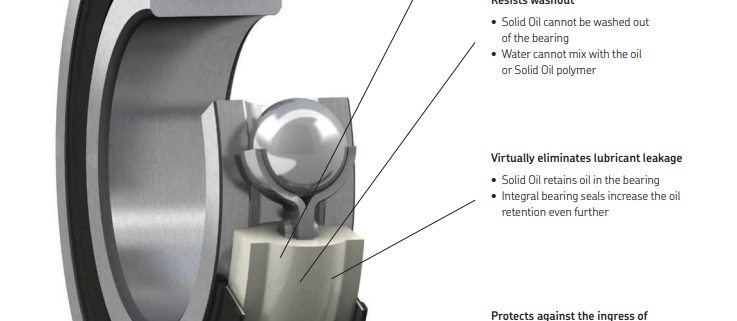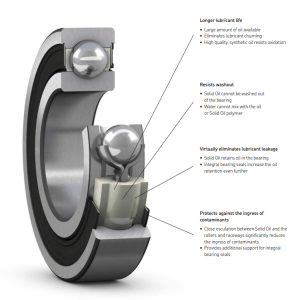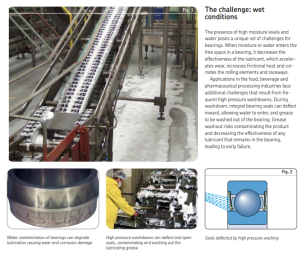What is Solid oil bearing?
Almost every brand has solid grease bearings, NSK calls molded oil bearings, SKF calls solid oil bearings, China CoatMaster Solid oil Bearings, solid oil is an oil-saturated polymer matrix that completely fills the free space in the bearing, encapsulating the rolling elements and cage , the polymer material has a porous structure with millions of micropores to hold the lubricating oil, since the pores are very small, the oil is retained in the material by surface tension.
When the oil-filled polymer material is pressed into the bearing, very small gaps are formed around the rolling elements and raceways, allowing the bearing components to rotate freely, and the oil that seeps into the gap provides good lubrication for the bearing from the start. This design has advantages over traditional lubricated oil bearings.
Solid oil bearings are designed for practical applications with moderate to high humidity and occasional exposure to water and other contaminants. Bearings using solid oil are lubricated for life and cannot be relubricated.
Solid oil bearings inject polymer materials into the bearing in the form of a mold. The polymer material absorbs saturated lubricating oil. The polymer material forms a small gap around the rolling elements, cages and raceways so that the bearing can rotate freely.
The unique design of the solid oil bearing can provide a steady supply of lubricating oil to the bearing. When a metal surface, such as a raceway in a bearing, slides over solid oil, it is covered with a uniform film of oil, and then, with only modest increases in operating temperature, the oil is pushed against the surface of the polymer matrix, polymerizing This “low” oil in the polymer matrix is because oil has a higher coefficient of thermal expansion than the polymer matrix, and because the viscosity of oil decreases with increasing temperature, excess oil reabsorbs when the bearing stops operating into the polymer matrix.
Solid oil prefills the bearing with more available lubricant. Solid oil bearings contain two to four times as much oil as conventional grease-lubricated bearings because the bearings are completely filled with solid oil, whereas grease-lubricated bearings typically only fill about one-third of the free space with grease.
Solid oil bearings keep out contaminants. Since the solid oil completely fills the bearing cavity, it is difficult for contaminants to reach the bearing contact surfaces. In highly polluted environments, CoatMaster recommends filling the free space in the housing with a suitable grease to provide an additional layer of protection.
Solid oil bearings require no seals and no relubrication. Solid oil contains a large amount of oil and is reusable so relubrication is not required, also solid oil bearings hold the lubricant inside so there is no need for seals to keep the bearing lubricated even on vertical shafts however, if If the unit already contains seals, the seals should be retained to prevent contamination.
In most applications, standard greases and oils provide equal amounts of lubrication to the bearings, however, in applications where relubrication of the bearings is not possible, solid oil bearings are a good solution, solid oils can also be effective In applications where high levels of contamination lead to premature bearing failure, solid oil is actually a 2-in-1 solution, providing lubrication to the bearing and an extremely effective seal by completely filling the bearing cavity.
For best performance in wet environments, it is strongly recommended to use solid oil bearings with integral contact seals whenever possible, when combined with solid oil and contact seals, the sealing capability is increased, while the solid oil acts as an axial support, preventing sealing Comes off and opens under pressure.
Application of Solid Oil Bearings
Solid oil bearings are widely used in harsh environment applications such as pellet mill equipment, steel mill rolling mills, glass factories, boiler equipment, kiln kiln cars, dirty or wet, corrosive chemicals, very cold, strong centrifugal forces, shafts, Difficult to maintain, oscillating motion, applications with high cleanliness requirements.





